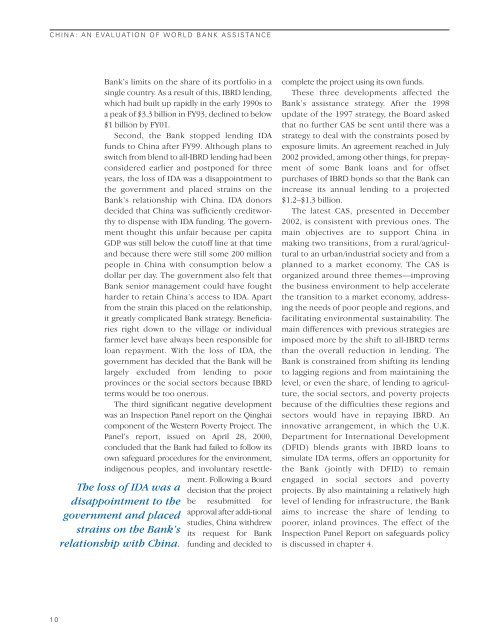Download Report - Independent Evaluation Group - World Bank
Download Report - Independent Evaluation Group - World Bank
Download Report - Independent Evaluation Group - World Bank
- No tags were found...
You also want an ePaper? Increase the reach of your titles
YUMPU automatically turns print PDFs into web optimized ePapers that Google loves.
CHINA: AN EVALUATION OF WORLD BANK ASSISTANCEThe loss of IDA was adisappointment to thegovernment and placedstrains on the <strong>Bank</strong>’srelationship with China.<strong>Bank</strong>’s limits on the share of its portfolio in asingle country. As a result of this, IBRD lending,which had built up rapidly in the early 1990s toa peak of $3.3 billion in FY93, declined to below$1 billion by FY01.Second, the <strong>Bank</strong> stopped lending IDAfunds to China after FY99. Although plans toswitch from blend to all-IBRD lending had beenconsidered earlier and postponed for threeyears, the loss of IDA was a disappointment tothe government and placed strains on the<strong>Bank</strong>’s relationship with China. IDA donorsdecided that China was sufficiently creditworthyto dispense with IDA funding. The governmentthought this unfair because per capitaGDP was still below the cutoff line at that timeand because there were still some 200 millionpeople in China with consumption below adollar per day. The government also felt that<strong>Bank</strong> senior management could have foughtharder to retain China’s access to IDA. Apartfrom the strain this placed on the relationship,it greatly complicated <strong>Bank</strong> strategy. Beneficiariesright down to the village or individualfarmer level have always been responsible forloan repayment. With the loss of IDA, thegovernment has decided that the <strong>Bank</strong> will belargely excluded from lending to poorprovinces or the social sectors because IBRDterms would be too onerous.The third significant negative developmentwas an Inspection Panel report on the Qinghaicomponent of the Western Poverty Project. ThePanel’s report, issued on April 28, 2000,concluded that the <strong>Bank</strong> had failed to follow itsown safeguard procedures for the environment,indigenous peoples, and involuntary resettlement.Following a Boarddecision that the projectbe resubmitted forapproval after addi-tionalstudies, China withdrewits request for <strong>Bank</strong>funding and decided tocomplete the project using its own funds.These three developments affected the<strong>Bank</strong>’s assistance strategy. After the 1998update of the 1997 strategy, the Board askedthat no further CAS be sent until there was astrategy to deal with the constraints posed byexposure limits. An agreement reached in July2002 provided, among other things, for prepaymentof some <strong>Bank</strong> loans and for offsetpurchases of IBRD bonds so that the <strong>Bank</strong> canincrease its annual lending to a projected$1.2–$1.3 billion.The latest CAS, presented in December2002, is consistent with previous ones. Themain objectives are to support China inmaking two transitions, from a rural/agriculturalto an urban/industrial society and from aplanned to a market economy. The CAS isorganized around three themes—improvingthe business environment to help acceleratethe transition to a market economy, addressingthe needs of poor people and regions, andfacilitating environmental sustainability. Themain differences with previous strategies areimposed more by the shift to all-IBRD termsthan the overall reduction in lending. The<strong>Bank</strong> is constrained from shifting its lendingto lagging regions and from maintaining thelevel, or even the share, of lending to agriculture,the social sectors, and poverty projectsbecause of the difficulties these regions andsectors would have in repaying IBRD. Aninnovative arrangement, in which the U.K.Department for International Development(DFID) blends grants with IBRD loans tosimulate IDA terms, offers an opportunity forthe <strong>Bank</strong> (jointly with DFID) to remainengaged in social sectors and povertyprojects. By also maintaining a relatively highlevel of lending for infrastructure, the <strong>Bank</strong>aims to increase the share of lending topoorer, inland provinces. The effect of theInspection Panel <strong>Report</strong> on safeguards policyis discussed in chapter 4.10
















